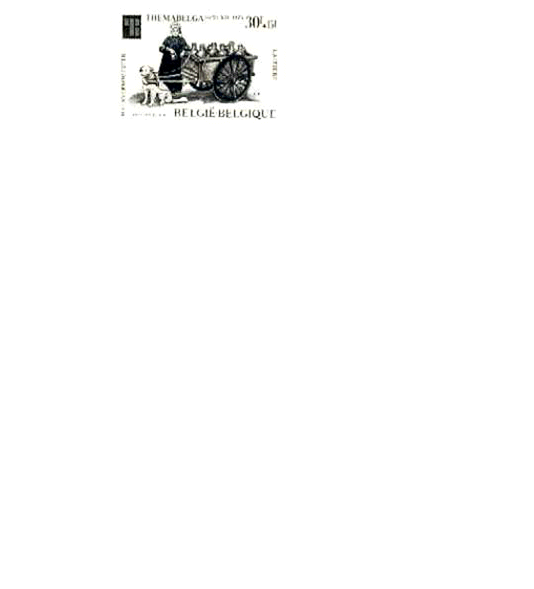History
The Laitière Flamande
The Legendary Milkmaids and Dog Carts of Flanders
The Laitière Flamande or Flemish Milkmaid is entrenched in the history of Flanders and Belgium. Historical documents, records and poems make mention of the milkmaids from the 17th century and earlier references may be available. Most milkmaids wore the traditional bonnet or some representation of it. The Bulletin was lucky enough to borrow some images of the historical Laitière Flamande from Marion Hubbard, Alfons and Annie Verheyen and anonymous others for the May 2003 Bulletin. The earliest image included in the slide show is a photo from 1875 Brussels with a sturdy, Bouvier-like character pulling the cart.

Noted American-born spy, Virginia Hall, who worked for the French as an agent and is the only woman to have received America’s Distinguished Service Cross, disguised herself as an elderly milkmaid from the 1943 period until the end of the war, despite losing a leg in an accident. Hunted by the Gestapo, a wanted poster circulated with the warning, "the woman with the limp is one of the most valuable Allied agents in France and we must find and destroy her". Painstakingly teaching herself how to walk without a limp, her elaborate disguise fooled the Germans, allowing her to collect and send invaluable intelligence and coordinate air drops in support of D-Day. The cart dog? A Bouvier.
Many of the photos which may represent some early Bouvier genetic contributors, do indicate the truth to the theory that if there was no horse the dog would be drafted — even the oddest collection of backyard mongrels. The Mâtin dogs in these photos, belie their “breed’s” contribution to the Bouvier gene pool. The sturdy construction, black mask and perfectly hung small, black drop-ears of these fawn dogs seems easily reminiscent of the color and pattern of many a modern Bouvier.
Photos in the slide show below reveal more Bouviers as well as assorted backyard mongrels. Note how the dogs were ganged in teams of two, three, four or five. Many of the photos here were tourist postcards from the early 1900’s through the 1950’s. In the central photos of the third page, three popular scenes using the same dog cart and team can be found, one “Selling Milk”, one checking the temperature and the other “Receiving a Ticket”. Interestingly, many tourists hated the dog carts immediately. The carting did take its toll on the dogs involved, with most carting dogs developing swaybacks due to the stress on their bodies and from the strap which fit over the dogs back. One account by John Stoddard in 1901 states, on dogcarts, "How often on my walks in Holland I have met peasants tramping along in whitewashed wooden shoes, besides a muzzled dog which sometimes staggered, and frequently lay down from sheer exhaustion! It makes no difference what their size or breed may be, all dogs are forced to labor unmercifully. My pity for them may be owing to the fact

that in America dogs are regarded merely as pets; but I confess that I always felt on observing Holland dogs compelled to draw heavy loads, much as I do at seeing children kept from play and made to labor in factories. Moreover, the work of Dutch Dogs does not end, when the merchandise is sold; for, when the chance is offered him, the driver seats himself in the cart, which frequently is heavy enough for a pony, and makes his wretched steed draw him home. It really exasperated me to see this treatment of the canine race in Holland. But the dogs are cheap, and the men either lazy or hard-hearted; hence so long as no society exists there to prevent it, man's most devoted friend and trusting comrade will be compelled to live a worse existence than is characterized by our expression, "A dog's life".
Dog carting was outlawed in Belgium and Holland for these reasons in 1955 and can only be shown at exhibitions with special permits today, including a television appearance by Caya Krinjse Locker and her Bouvier. Very special thanks to Marion Hubbard and Alfons and Annie Verheyen for the use of some of these historical photographs. We loved them! BB
Please enjoy the slide show below which contains photos from Belgium, France, Holland and the United States, 1875-1960

The Laitière Flamande | Caprice | Early Twentieth Century | Herding Trial

